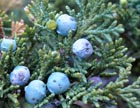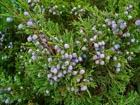
Prostrate plant in the Parque Natural Sierra de las Nieves, Spain [Jose Angel Campos Sandoval].

Foliage and mature female cones on the plant shown above [Jose Angel Campos Sandoval].

Foliage and mature female cones on a plant in habitat west of Abriès, Queyras, France (44.803° N, 6.904° E), elevation 1,600 meters [Réjean Drouin, 2014.07].

Juniperus sabina
Linnaeus 1753, p. 1039
Common names
Savin (Vidakovic 1991).
Taxonomic notes
Three varieties (Farjon 2005):
Juniperus sabina var. arenaria (E.H. Wilson) Farjon 2005. Type: China, Qinghai Lake, J.F. Rock 13346. Syn.:
- Juniperus chinensis L. var. arenaria E.H. Wilson 1928;
- Juniperus arenaria (E.H. Wilson) Florin 1948.
Juniperus sabina var. davurica (Pall.) Farjon 2005. Type: Russia, Amur River. Syn.:
- Juniperus davurica Pall. 1789;
- Juniperus foetida Spach var. davurica (Pall.) Spach 1841;
- Sabina davurica (Pall) Antoine 1857;
- Juniperus davurica Pall. subsp. maritima Urussov 1981.
Juniperus sabina var. sabina. Type locality unknown. Syn.:
- Juniperus lusitanica Mill. 1768;
- Juniperus sabina var. cupressifolia Aiton 1789;
- Juniperus sabina var tamariscifolia Aiton 1789;
- Juniperus humilis Salisb. 1796;
- Juniperus foetida Spach 1841;
- Juniperus foetida Spach var. multicaulis Spach 1841;
- Juniperus foetida Spach var sabina (L.) Spach 1841;
- Juniperus sabina var. vulgaris Endl. 1847;
- Sabina vulgaris Antoine 1857;
- Sabina vulgaris Antoine var. arborescens Antoine 1857;
- Sabina officinalis Garcke 1858;
- Juniperus × kanitzii Csató 1886;
- Sabina alpestris Jord. 1903;
- Sabina vulgaris Antoine var. yulinensis T.C. Chang et C.G. Chen 1981;
- Juniperus sabina var. monosperma C.Y. Yang 1993;
- Juniperus sabina var. yulinensis (T.C. Chang et C.G. Chen) Y.F. Yu et L.K. Fu 1998.
Description
"A shrub up to 5 m high, with irregular crown, rarely erect and usually more or less prostrate. Branches with upturned ends. Bark on old trees reddish-brown. Shoots slender, up to 1 mm in diameter, rounded to slightly angled. Shoots and leaves emit an unpleasant odour when rubbed. Foliage dimorphic; on young plants and sterile branches leaves needle-like, in whorls, 4 mm long, pointed, glaucous above; scale leaves decussate, ovate, 1-3 mm long, with a dorsal gland. The species monoecious or dioecious. Fruit globose to ovate, 5-7 mm long, bluish-black, pruinose, composed of 4 to 6 scales, on a curved petiole; ripening in the autumn of the first year or in the following spring. Seeds 1-3 to a fruit, ovate and furrowed. The fruit and leaves are poisonous" (Vidakovic 1991).
Distribution and Ecology
S & C Europe, Asia Minor, the Caucasus, Ural and Siberia; in mountains at 1400-2300 m. "It is very tolerant to cold, drought and gases. It has no special requirements regarding soil" (Vidakovic 1991). Among other places, it is native to Croatia. Hardy to Zone 3 (cold hardiness limit between -39.9°C and -34.4°C) (Bannister and Neuner 2001, variety not specified).
Remarkable Specimens
No data as of 2023.03.03.
Ethnobotany
A popular ornamental (Vidakovic 1991). In traditional medicine, its foliage was used as an abortifascient. For this reason, cultivation of this species was long prohibited in France (L'Herbier Virtuel 1998).
Observations
Remarks
The epithet is from sabine (or variants), an old French name for junipers.
The foliage and the seeds contain sabinol (a terpenic alcohol) and gallic acid, which is transformed into pyrogallol. Consumption of the foliage causes a severe irritation of all mucous membranes. The sabinol attacks the nervous system, causing convulsions. The pyrogallol blocks the intestinal circuit completely. Death occurs quickly (L'Herbier Virtuel 1998).
Citations
L'Herbier Virtuel. 1998. http://www.lenet.fr/vegetal/herbier/herbier2.html, accessed 1998.10.05, now defunct.
See also
Elwes and Henry 1906-1913 at the Biodiversity Heritage Library. This series of volumes, privately printed, provides some of the most engaging descriptions of conifers ever published. Although they only treat species cultivated in the U.K. and Ireland, and the taxonomy is a bit dated, still these accounts are thorough, treating such topics as species description, range, varieties, exceptionally old or tall specimens, remarkable trees, and cultivation. Despite being over a century old, they are generally accurate, and are illustrated with some remarkable photographs and lithographs.
Farjon (2005) provides a detailed account, with illustrations.



